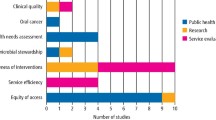Key Points
-
PROHIs provide a means of recording the patients view of their own dental health
-
PROHIs are capable of describing and valuing dental health care
-
PROHIs are capable of identifying population subgroups in which there is a shortfall in dental health.
Abstract
An understanding of a broader concept of health is increasingly important for all health professionals, including dentists, and has recently been incorporated as a key principle in the Government White Paper, The New NHS1. This aims to deliver a dependable, high quality, egalitarian health service. In the past, performance measurements in the UK have often relied simply on those areas which are most easily quantified. For example, within the hospital service, performance was measured in terms of the cost and the number of finished consultant episodes, from which the 'purchaser efficiency index' was calculated. This tended to produce a driving force rewarding those doing more rather than those doing more better. It is analogous to the system which has been the backbone of NHS dental practice for many years, 'fee per item of service', where throughput is rewarded rather than outcome. However, the White Paper has signalled a move away from simply counting activity. From April 1999 within the hospital service the purchaser efficiency index has been replaced with more rounded measures, reflecting the changing concepts of health, in a new broader performance framework to determine what really counts for patients. It will focus on measuring health improvement, fairer access, better quality and outcome, including the views of patients.
Similar content being viewed by others
Log in or create a free account to read this content
Gain free access to this article, as well as selected content from this journal and more on nature.com
or
References
Secretary of State for Health. The New NHS. 1997; London: Stationery Office.
Cohen L K, Jago J D. Toward the formulation of sociodental indicators. Int J Health Serv 1976; 6: 681–98.
Aitchison K, Dolan T. Development of the geriatric oral health assessment index. J Dent Educ 1990; 54: 680–7.
Rosenberg D, Kaplan S, Senie R, Badner V. Relationships among dental functional status, clinical dental measures and generic health measures. J of Dent Educ 1988; 52: 653–657.
Cushing A M, Sheiham A, Maizels J. Developing sociodental indicators-the social impact of disease. Community Dent Health. 1986; 3: 3–17.
Reisine S. Dental disease and work loss. J Dent Res 1984: 63: 1158–61.
Reisine S T, Miller J A. A longitudinal study of work loss related to dental diseases. Soc Sci Med 1985; 21: 1309–14.
Gilson B S, Gilson J S, Bergner M, Bobbit R A, Kressell S, Pollard W E, Vesselago M. The sickness impact profile. Development of an outcome measure of health care. Am J of Public Health 1975; 65: 1304–1310.
The EuroQol group. EuroQol -- a new facility for the measurement of health related quality of life. Health Policy 1990; 16: 199–208.
Locker D. Measuring oral health: a conceptual framework. Community Dent Health 1988; 5: 3–18.
Leao A, Sheiham A. The development of a socio-dental measure of dental impacts on daily living. Community Dent Health. 1996; 13: 22–26.
Allen D F, Locker D. Do item weights matter? An assessment using the oral health impact profile. Community Dent Health 1997; 14: 133–138.
Locker D, Miller Y. Evaluation of subjective oral health status indicators. J of Public Health Dent 1994; 54: 167–176.
Slade S G, Spencer J A. Development and evaluation of the Oral Health Impact Profile. Community Dent Health 1994; 11: 3–22.
Slade G D. Derivation and validation of a short-form oral health impact profile. Community Dent Oral Epidemiol 1997; 25: 284–90.
Leao A. The development of measures of dental impact on daily living. PhD thesis, 1993; University College London.
Kind P, Boyd T, Corson M A. Measuring dental health status: calibrating a context-specific instrument. 1998; In proceedings of International Society for Technology in Health Care, Ottawa, Canada.
Kind P, Boyd T, Corson M A. Measuring dental health status: comparison of EQ-5D and DS-QoL. 1998; In proceedings of the 14th EuroQoL Scientific Plenary, Hanover, Germany.
Steele J G, Sheiham A, Marcenes W, Walls A. National Diet and Nutrition Survey: people aged 65 years and over. Volume 2. Report of the Oral Health Survey. 1998; London: Stationery Office.
Strauss R P, Hunt R J. Understanding the value of teeth to older adults: influences on the quality of life. J Am Dent Assoc 1993; 124: 105–10.
Dental Practice Board annual prescribing profile. April 1995–March 1996.
Author information
Authors and Affiliations
Additional information
Refereed Paper
Rights and permissions
About this article
Cite this article
Corson, M., Boyd, T., Kind, P. et al. Measuring oral health: does your treatment really make a difference. Br Dent J 187, 481–484 (1999). https://doi.org/10.1038/sj.bdj.4800310
Received:
Accepted:
Published:
Issue date:
DOI: https://doi.org/10.1038/sj.bdj.4800310
This article is cited by
-
Promoting menstrual health among persian adolescent girls from low socioeconomic backgrounds: a quasi-experimental study
BMC Public Health (2012)
-
The effectiveness of out-of-hours dental services: I. pain relief and oral health outcome
British Dental Journal (2005)
-
The impact of attendance patterns on oral health in a general dental practice
British Dental Journal (2002)


